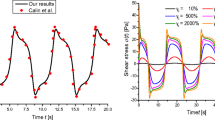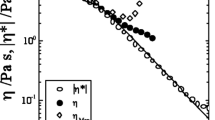Abstract
The weakly nonlinear rheology of a surfactant solution of wormlike micelles is investigated from both a modeling and experimental perspective using the framework of medium amplitude parallel superposition (MAPS) rheology. MAPS rheology defines material functions, such as the third-order complex compliance, which span the entire weakly nonlinear response space of viscoelastic materials to simple shear deformations. Three-tone oscillatory shear deformations are applied to obtain feature-rich data characterizing the third-order complex compliance with high data throughput. Here, data for a CPyCl solution are compared to the analytical solution for the MAPS response of a reptation-reaction constitutive model, which treats micelles as linear polymers that can break apart and recombine in solution. Regression of the data to the model predictions provides new insight into how these breakage and recombination processes are affected by shear, and demonstrates the importance of using information-rich data to infer precise estimates of model parameters.
Graphical abstract








Similar content being viewed by others
References
Cates ME (1990) Nonlinear viscoelasticity of wormlike micelles (and other reversibly breakable polymers). J Phys Chem 94(1):371–375
Doi M, Edwards SF (1986) The Theory of Polymer Dynamics. International series of monographs on physics. Clarendon Press, Oxford
Ewoldt RH, Bharadwaj NA (2013) Low-dimensional intrinsic material functions for nonlinear viscoelasticity. Rheol Acta 52:201
Fardin MA, Divoux T, Guedeau-Boudeville MA, Buchet-Maulien I, Browaeys J, McKinley GH, Manneville S, Lerouge S (2012) Shear-banding in surfactant wormlike micelles: elastic instabilities and wall slip. Soft Matter 8(8):2535–2553
Giesekus H (1982) A simple constitutive equation for polymer fluids based on the concept of deformation-dependent tensorial mobility. J Non-Newtonian Fluid Mech 11(1):69–109
Graham RS, Likhtman AE, McLeish TCB, Milner ST (2003) Microscopic theory of linear, entangled polymer chains under rapid deformation including chain stretch and convective constraint release. J Rheol 47(5):1171–1200
Gurnon AK, Wagner NJ (2012) Large amplitude oscillatory shear (LAOS) measurements to obtain constitutive equation model parameters: Giesekus model of banding and nonbanding wormlike micelles. J Rheol 56 (2):333–351
Hulsen MA (1990) A sufficient condition for a positive definite configuration tensor in differential models. J Non-Newtonian Fluid Mech 38(1):93–100
Kim S, Mewis J, Clasen C, Vermant J (2013) Superposition rheometry of a wormlike micellar fluid. Rheol Acta 52(8):727–740
Lennon KR, McKinley GH, Swan JW (2020a) Medium amplitude parallel superposition (MAPS) rheology. Part 1: Mathematical framework and theoretical examples. J Rheol 64(3):551–579
Lennon KR, Geri M, McKinley GH, Swan JW (2020b) Medium amplitude parallel superposition (MAPS) rheology. Part 2: Experimental protocols and data analysis. J Rheol 64(5):1263–1293
Milner ST, McLeish TCB, Likhtman AE (2001) Microscopic theory of convective constraint release. J Rheol 45(2):539–563
Moorcroft RL, Fielding SM (2014) Shear banding in time-dependent flows of polymers and wormlike micelles. J Rheol 58(1):103–147
Oldroyd JG, Wilson AH (1950) On the formulation of rheological equations of state. Proc R Soc London Ser A Math Phys Sci 200(1063):523–541
Peterson JD, Cates ME (2020) A full-chain tube-based constitutive model for living linear polymers. J Rheol 64(6):1465–1496
Pipe CJ, Kim NJ, Vasquez PA, Cook LP, McKinley GH (2010) Wormlike micellar solutions: II. Comparison between experimental data and scission model predictions. J Rheol 54(4):881–913
Rodrigues R (2015) Oil field exploration: Worm-like micelle applications. In: Somasundaran P (ed) Encyclopedia of surface and colloid science. CRC press, pp 5002–5010
Rubin FK, Van Blarcom D (1983) Viscous compositions containing amido betaines and salts. US Patent 4,375,421
Saengow C, Giacomin AJ, Grizzuti N, Pasquino R (2019) Startup steady shear flow from the Oldroyd 8-constant framework. Phys Fluids 31(6):063101
Salmon JB, Colin A, Manneville S, Molino F (2003) Velocity profiles in shear-banding wormlike micelles. Phys Rev Lett 90(22):228303
Singh PK, Soulages JM, Ewoldt RH (2019) On fitting data for parameter estimates: residual weighting and data representation. Rheol Acta 58(6):341–359
Smith WL (1995) Viscoelastic cleaning compositions with long relaxation times. US Patent 5,389,157
Spenley NA, Cates ME, McLeish TCB (1993) Nonlinear rheology of wormlike micelles. Phys Rev Lett 71(6):939–942
Vasquez PA, McKinley GH, Cook LP (2007) A network scission model for wormlike micellar solutions: I. Model formulation and viscometric flow predictions. J Non-Newtonian Fluid Mech 144(2):122–139
Yang J (2002) Viscoelastic wormlike micelles and their applications. Curr Opin Colloid Interface Sci 7(5):276–281
Funding
K.R.L. was supported by the U.S. Department of Energy Computational Science Graduate Fellowship program under Grant No. DE-SC0020347.
Author information
Authors and Affiliations
Corresponding author
Additional information
Publisher’s note
Springer Nature remains neutral with regard to jurisdictional claims in published maps and institutional affiliations.
Supplementary Information
Appendices
Appendix: A. The reptation-reaction model equations
The stress tensor in the reptation-reaction model is specified by Eqs. 4 and 5, along with the companion Eq. 6. Completing the model specifications requires equations for the tube creation rate \({\mathscr{B}}(v)\), destruction rate \(\mathcal {D}(v)\), and the evolution of the \(\boldsymbol {Q}(\boldsymbol {E}_{t^{\prime }t})\) tensor describing tube elongation. The creation and destruction rates are specified by two ensemble- averaged integrals over the position of the end of a micelle, X(t):
Angular brackets here represent ensemble averages over the stochastic processes of diffusion and reactions at the end of the micelles, such as breakage and recombination. In these expressions, \(\bar {L}\) represents the time-averaged micelle length L(t), and \(\hat {\tau }\) a time scale related to the recombination process (this time scale is distinct from the time scale τ defined in the main text, which reflects a time scale associated with diffusion of the end of the micelle).
The tensor \(\boldsymbol {Q}(\boldsymbol {E}_{t^{\prime }t})\) represents the average orientation over an isotropic distribution of unit vectors u:
where \(\mathcal {S}\) represents the surface of the unit sphere, and |x| represents the L2-norm of a vector x.
Appendix: B. MAPS response of the reptation-reaction model
The third-order complex modulus of the reptation-reaction model may be written as the sum of three terms:
The term \(G^{*}_{3,{\mathscr{B}}}\) represents the contribution due to nonlinearity in the tube creation function \({\mathscr{B}}(v)\):
The term \(G^{*}_{3,\mathcal {D}}\) represents the contribution due to nonlinearity in the tube destruction function \(\mathcal {D}(v)\):
The term \(G^{*}_{3,\boldsymbol {Q}}\) represents the contribution due to nonlinearity in the \(\boldsymbol {Q}(\boldsymbol {E}_{t^{\prime }t})\) tensor. Because, in simple shear, \(\boldsymbol {Q}(\boldsymbol {E}_{t^{\prime }t})\) may be written as a quadratic polynomial in the accumulated strain (see the Supporting Information), this factor arises as a time-strain separable contribution to the third-order complex modulus. It may therefore be expressed in terms of the linear modulus (Eq. ??):
Finally, the parameter α is defined in terms of the limiting slope of \(\mathcal {D}(v)\) (or \({\mathscr{B}}(v)\)):
where v = 0 in simple shear corresponds to the limit of either zero shear-rate or zero shear stress.
Rights and permissions
About this article
Cite this article
Lennon, K.R., McKinley, G.H. & Swan, J.W. Medium amplitude parallel superposition (MAPS) rheology of a wormlike micellar solution. Rheol Acta 60, 729–739 (2021). https://doi.org/10.1007/s00397-021-01300-5
Received:
Revised:
Accepted:
Published:
Issue Date:
DOI: https://doi.org/10.1007/s00397-021-01300-5




